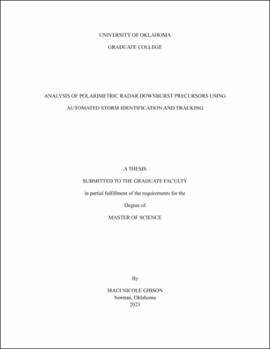| dc.description.abstract | Strong thunderstorm winds produced by downbursts pose a threat to life, property, and aviation, yet they remain challenging to predict in advance. Current operational understanding of radar-based downburst precursors includes a divergent or convergent velocity signature at the surface or mid-levels, respectively, a descending radar reflectivity (Z) core (DRC), and environmental characteristics (e.g., downdraft convective available potential energy (DCAPE), steep lapse rates) that are favorable for downburst generation. However, divergence signatures only occur once downbursts have reached the surface and may not be observed at distances far from the radar, and prior studies have shown that not every downburst is reliably associated with mid-level convergence or a DRC. Similarly, environmental parameters are useful when forecasting for a broad area, but not every thunderstorm in an environment with conditions favorable for downbursts will produce one.
Recent work has begun exploring whether polarimetric radar offers insight into additional downburst precursor signatures. Previous studies using polarimetric radar to analyze downburst-producing thunderstorms have observed signatures such as a descending specific differential phase (KDP) core and a trough of decreased differential reflectivity (ZDR) collocated with decreased co-polar correlation coefficient (rhv) extending below the melting layer. However, these studies either manually analyzed individual signatures or focused solely on case studies. This research expands on those studies by using the Multi-Cell Identification and Tracking (MCIT) algorithm to automate storm detection and analyze 41 downburst cases which span most regions of the contiguous United States. For each case, polarimetric radar variables, signatures, and derived products hypothesized to potentially be relevant to downburst formation, including Z, KDP, vertically integrated liquid (VIL), ZDR column depth, convergence, and divergence, are analyzed to find any consistent patterns leading up to downburst events. Geographic and environmental variability are investigated as well.
Individual case analysis revealed that a DRC appeared within a volume scan of storm report (SR) time in 88% of cases, and a KDP core was present and/or descending in 95% of cases, up to 15 to 30 minutes prior to the SR time in several cases. A ZDR trough was present in 98% of cases with a collocated rhv drop in 88% of cases within 10 minutes of the SR time for most cases, and the magnitude of low-level divergence and mid-level convergence reached a threshold of 0.0025 s^-1 in 85% and 76% of cases, respectively. Analysis of all cases together revealed that divergence, velocity, and differential velocity display the most prominent signals near the surface at or just after the divergence signature (DS) time; aloft, KDP at and 1 km below the freezing level, mid-level convergence, and VIL display the most prominent signals 5 minutes or more before the DS time. Analyses based on region and environmental favorability produced similar information, indicating that higher KDP and lower divergence, velocity, VIL, and ZDR column depth values were most common in eastern cases, as well as cases with WINDEX and 0–2-km LR less than 60 and 8 º km^-1, respectively. Conversely, higher divergence, velocity, VIL, and ZDR column depth and lower KDP values were more common in western cases, as well as cases with WINDEX and 0–2-km LR of greater than 60 and 8 º km^-1, respectively. These results aligned well with and confirmed findings from past studies. | en_US |
